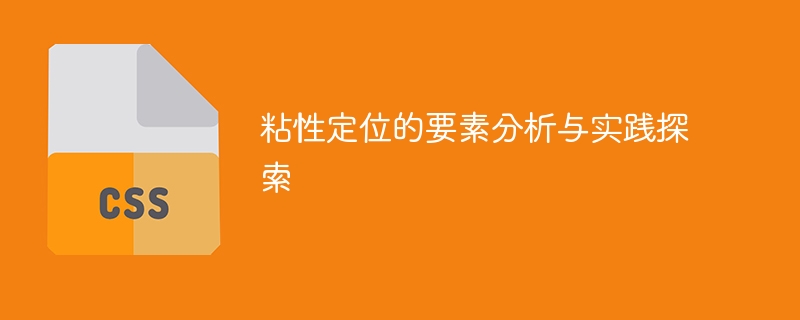Home >Web Front-end >CSS Tutorial >Analyze and conduct practical exploration of the elements of sticky positioning
Analyze and conduct practical exploration of the elements of sticky positioning
- PHPzOriginal
- 2024-01-28 08:14:181022browse

Element Analysis and Practical Exploration of Sticky Positioning
With the rapid development of the Internet, the importance of Web interface design has become increasingly prominent. In design, user experience has become one of the most important considerations. In many web pages and applications, sticky positioning has become an effective means to improve user experience. This article will analyze the elements of sticky positioning and explore its specific practices in practical applications.
Sticky positioning is a technical means to maintain the position of an element during scrolling. It can make the element fixed at a certain position on the page until it is scrolled to a specific position before making corresponding positioning changes. In terms of design, sticky positioning is mainly implemented through the position attribute of CSS, of which the commonly used attribute value is sticky.
First of all, one of the elements to achieve sticky positioning is element selection. In practical applications, sticky positioning is usually used on some fixed navigation bars or toolbars. These elements usually need to remain visible as the user scrolls the page to make it easier for the user to navigate or use functionality at any time. Therefore, when choosing sticky positioning elements, you need to consider the importance and frequency of use of the element, as well as its impact on the overall page layout. Only by rationally selecting sticky positioning elements can the user experience be better improved.
Secondly, sticky positioning also needs to consider the target location. The target position refers to the change in positioning of the sticky element when the page is scrolled to a specific position. Common target locations are usually the top or bottom of an element. Sticky positioning allows an element to stay fixed at a specific location on the page when it is scrolled to its target position so that it is always easily accessible and usable by users. However, it should be noted that the target position of sticky elements should be set appropriately to avoid blocking content or causing interface clutter.
In addition, sticky positioning also needs to consider some details in practice. For example, animation effects and transition effects when scrolling. Through appropriate animation effects, the changes of sticky elements can be made smoother and the user's comfort can be increased. In addition, the transition effect can also make the interface changes more natural and layered through dynamic transition. Handling these detailed issues can further improve the user experience of sticky positioning.
In practical applications, sticky positioning can be implemented in many ways. A common way is to define the style and behavior of sticky positioned elements through CSS. For example, you can define the target position by setting the element's position property to sticky and specifying a top or bottom property. At the same time, JavaScript can also be used to achieve complex sticky positioning effects, such as dynamically changing the style or position of elements during scrolling.
In summary, sticky positioning is a design method to improve user experience, and its elements include element selection, target position and handling of details. In practice, it is necessary to select appropriate sticky positioning elements based on specific application scenarios and needs, and set their target positions and animation effects reasonably. Through effective sticky positioning design, users can improve the convenience of navigation and function use, thereby improving the overall user experience.
The above is the detailed content of Analyze and conduct practical exploration of the elements of sticky positioning. For more information, please follow other related articles on the PHP Chinese website!

